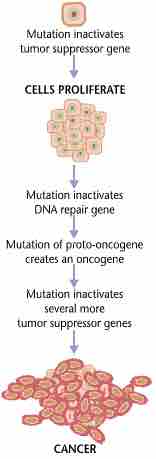Cancer describes a broad group of diseases, all involving unregulated cell growth caused by genetic mutations. Cancers comprise the malignant (having a tendency to become worse) subset of neoplasms—a cell or group of cells that undergo unregulated growth and form a mass of tissue—often referred to as a tumor. A major hallmark of cancers is metastasis, the ability of the cancer to spread between tissues and organs within the body.
Non-malignant tumors are referred to as benign; they are typically slower growing and are often surrounded by a membrane of connective tissue that prevents metatasis. A common example of a benign tumor is a skin mole.
While typically asymptomatic, benign tumors can impact health, usually by impairing organ function through the compression of blood vessels or nerve fibers.
Chest x-ray showing lung cancer in the left lung
A tumor present in the lung is marked via the black box.
Hallmarks of Cancer
Due to the wide variety of cancerous diseases, six hallmarks are used to group and define cancers:
- Unregulated cell growth and division.
- Continuous growth and division even given contrary signals.
- Avoidance of programmed cell death.
- Unlimited cell division.
- Promoting vascularisation.
- Invasion of tissue and formation of metastases.
Signs and Symptoms
Cancer is typically asymptomatic at onset; its symptoms appear as the tumor grows and invades other tissues. Initial symptoms are typically associated with the loss of organ function at the tumor site.
For example, patients with lung cancer often present with symptoms including breathlessness and chronic cough, but can vary widely between patients. Due to this variation and the association of symptoms with other disorders, an early diagnosis of cancer is often difficult.
As the disease progresses, systemic symptoms such as weight loss, fever, and tiredness can develop. Additionally, symptoms associated with metastasis—such as enlarged lymph nodes, an enlarged liver, or an enlarged spleen—can develop.
Classification
Cancers are classified by the type of cell that the tumor cells resemble with the presumption that this shows the origin of the tumor. These include:
- Carcinoma: Cancers derived from epithelial cells. This group includes many of the most common cancers, particularly in the aged, and include nearly all those developing in the breast, prostate, lung, pancreas, and colon.
- Sarcoma: Cancers arising from connective tissue (i.e., bone, cartilage, fat, nerve), each of which develop from cells originating in the mesenchymal cells outside the bone marrow.
- Lymphoma and leukemia: These two classes of cancer arise from hematopoietic (blood-forming) cells that leave the marrow and tend to mature in the lymph nodes and blood, respectively.
- Germ cell tumor: Cancers derived from pluripotent cells, most often presenting in the testicle or the ovary (seminoma and dysgerminoma, respectively).
- Blastoma: Cancers derived from immature precursor cells or embryonic tissue. These are also most common in children.
Causes of Cancer
Cancers are primarily associated with environmental factors such as smoking, obesity, high alcohol consumption, radiation exposure, and environmental pollutants. However, it is important to note that exposure to these factors merely imparts an increased risk of the development of cancer, rather than ensuring its development.
There is some element of genetic risk in the development of cancers, with some specific subsets having a very high genetic risk component. For example, familial mutations of the BRCA1 and BRCA2 genes are associated with an increased risk of developing breast cancer.
Genetics of Cancer
Cancer is a disease of dysregulated cell proliferation. At the genetic level, cell proliferation can either be promoted or repressed via the expression of key genes; with alteration of these genes, expression or function via mutation, as induced by the factors discussed above, result in dysregulated proliferation.
Affected genes can be divided into two broad categories.
- Oncogenes are genes that promote cell growth and reproduction, such as the gene MYC.
- Tumor suppressor genes are genes that inhibit cell division and survival, such as the TP53 gene.
Malignant transformation can occur through the formation of novel oncogenes, the inappropriate over-expression of normal oncogenes, or by the under-expression or disabling of tumor suppressor genes. Typically, changes in multiple genes are required to transform a normal cell into a cancer cell.

Pathway of cancer development
Cancer develops due to mutations in several key genes that control cell proliferation and survival.
Therapies
Cancer therapy varies by patient, tumor type, and location. The most common treatments include:
- Surgery: This is the primary method of treatment for most isolated, solid cancers. It is also typically an important part of making the definitive diagnosis of tumor type and character through biopsies.
- Chemotherapy: In addition to surgery, this has proven useful in a number of different cancer types. Chemotherapy refers to the administration of a toxin that targets rapidly dividing cells and promotes their cell death. It is nonspecific to tumors and it's effect on other rapidly dividing cells, such as those of the hair follicle, give rise to the side-effects associated with chemotherapy.
- Radiotherapy: Radiation therapy involves the use of ionizing radiation to specifically target a tumor within the body, leading to its death. Radiation is typically used in addition to surgery and/or chemotherapy. For certain types of cancer, such as early head and neck cancer, it may be used alone.